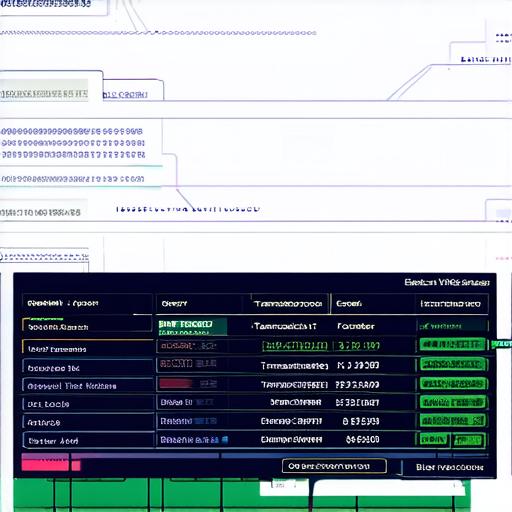What is the function of a blockchain explorer
If you are familiar with blockchain technology, you probably know what a blockchain explorer is. But for those who don’t, a blockchain explorer is a tool that allows you to view and analyze the details of transactions on a blockchain network.
Understanding Blockchains
Before we delve into the role of a blockchain explorer, let’s first understand what a blockchain is. A blockchain is a distributed ledger that records transactions across multiple computers. It is designed to be secure, transparent, and immutable. Transactions on a blockchain are verified by a network of nodes, which ensures that the data recorded on the blockchain is accurate and trustworthy.
What is a Blockchain Explorer?
A blockchain explorer is a web-based tool that allows users to view the details of transactions on a blockchain network. It provides an easy-to-use interface that displays information about the network, including the current number of blocks, the latest transactions, and more. The most popular blockchain explorers include Blockchair, Etherscan, and CoinGecko.
Why Do We Need a Blockchain Explorer?
There are several reasons why we need a blockchain explorer:
- Transparency: One of the main benefits of blockchain technology is its transparency. A blockchain explorer allows users to view the details of transactions on a network, which helps to increase trust and accountability.
- Security: Blockchains are designed to be secure, but this does not mean that they are immune to attacks. A blockchain explorer can be used to monitor the network for suspicious activity or anomalies that could indicate a potential security breach.
- Auditability: A blockchain explorer provides an easy-to-use interface for auditing transactions on a blockchain network. It allows users to search for specific transactions, view the details of individual transactions, and generate reports that can be used for compliance purposes.
- Research: Blockchains are still a relatively new technology, and there is much to learn about their inner workings. A blockchain explorer provides an easy-to-use tool for studying the network and analyzing transactions. It also allows researchers to collaborate with other experts in the field, sharing data and insights that can help advance our understanding of blockchain technology.
- Education: A blockchain explorer is a great tool for educating people about blockchain technology. It provides an easy-to-use interface that allows users to explore the network and learn more about how it works. This can help people understand the potential applications of blockchain technology in various industries, and encourage them to explore its possibilities further.
Real-Life Examples of Blockchain Explorers
Let’s take a look at some real-life examples of how blockchain explorers can be used:
- Investigation: In 2018, a hacker stole over $53 million worth of cryptocurrency from a Japanese exchange called Coincheck. The hack was traced to a specific transaction on the Ethereum network, which allowed investigators to track down the stolen funds and recover some of them.
- Compliance: In the financial industry, blockchain explorers are often used for compliance purposes. For example, banks can use blockchain explorers to monitor transactions for suspicious activity or to ensure that they comply with anti-money laundering regulations.
- Research: Blockchain explorers are also commonly used by researchers to study the network and analyze transactions. For example, a researcher might use a blockchain explorer to analyze the flow of funds on the Bitcoin network during a particular time period, in order to better understand how it is being used.
- Education: A blockchain explorer can be a great tool for educating people about blockchain technology. For example, a teacher might use a blockchain explorer to help their students understand how transactions are recorded on the Bitcoin network, and how they can be verified by nodes on the network.
Comparison with Traditional Databases
One way to understand the value of a blockchain explorer is to compare it with traditional databases. While both types of systems allow you to view and analyze data, there are several key differences:
- Decentralization: A blockchain is decentralized, meaning that it is not controlled by a single entity or organization. This makes it much more resistant to attacks and manipulation than traditional centralized databases.
- Transparency: Blockchains are designed to be transparent, meaning that all participants on the network can view the details of transactions. This helps to increase trust and accountability, which is especially important in industries such as finance.
- Immutability: Once a transaction is recorded on a blockchain, it cannot be altered or deleted. This makes the data on a blockchain much more trustworthy than data stored in traditional databases.
- Security: Blockchains are designed to be secure, with multiple layers of encryption and other security measures in place to prevent attacks. Traditional databases, on the other hand, are often vulnerable to hacking and other forms of cybercrime.
How to Use a Blockchain Explorer
Using a blockchain explorer is relatively straightforward. Here are the basic steps:
- Choose a blockchain network: There are many different blockchain networks to choose from, including Bitcoin, Ethereum, and others. Choose the network that you want to explore.
- Find a blockchain explorer: There are many different blockchain explorers available online. Choose one that is easy to use and provides the features that you need.
- Enter a transaction hash or address: Once you have chosen a blockchain explorer, you can enter a transaction hash or address to view the details of a specific transaction.
- Analyze the data: The blockchain explorer will display information about the transaction, including the sender, receiver, amount, and other relevant data. You can use this information to analyze the network and gain insights into how it is being used.
- Generate reports: Many blockchain explorers allow you to generate reports that summarize the data on the network. These reports can be used for compliance purposes or for research.

Summary
A blockchain explorer is a powerful tool that can be used for a variety of purposes, including investigation, compliance, research, and education. By providing an easy-to-use interface for viewing and analyzing transactions on a blockchain network, blockchain explorers help to increase trust, accountability, and security on the network. Whether you are a researcher, investor, or simply someone who is interested in learning more about blockchain technology, a blockchain explorer can be a valuable resource.



